History
The idea for a hall and recreation facilities in the village came from local men who had fought and survived World War One. Some 150 men from the village had gone to war, with some 15 ‘Brindlers’ making the ultimate sacrifice.
Minutes of Brindle Parish Council for the 26th January 1920 recorded that…
“At 8.30 p.m. a deputation was received forming a Committee of Messrs. Grime, Moss, Hindle and Stott asking for support for a proposed Recreation Room for Brindle. This support was granted four voting in favour and two either against it or neutral”
Things moved on when on Saturday, 18th August 1923 the Parish Institute was officially opened by Lord Chesham. His Lordship, who was a member of the Cavendish family and related to the Duke of Devonshire, had land in the village and donated the site for a recreation room with a bowling green and tennis court; a football pitch was created sometime later on an adjacent farmer’s field.
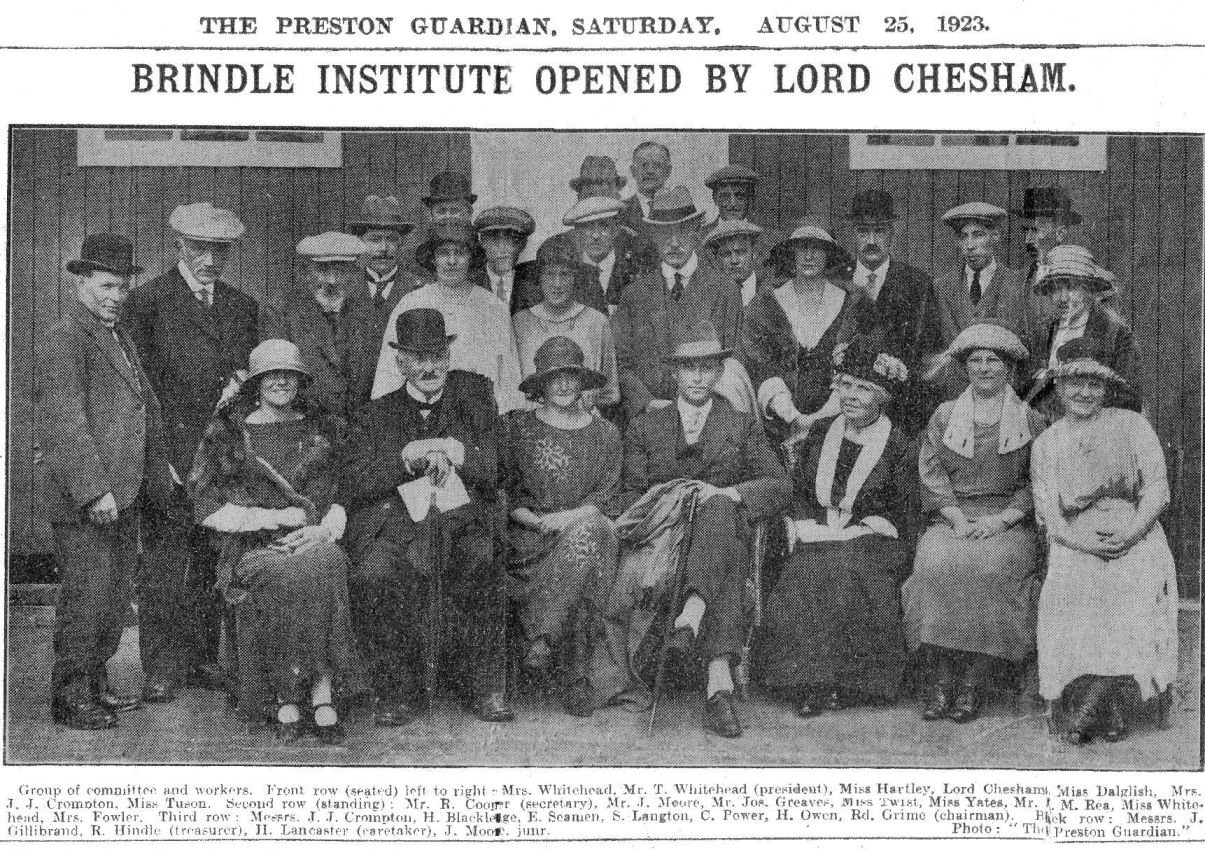
The original buildings were former Army huts from Salisbury Plain and the whole project cost £900. The community played its part in transporting the huts from Hoghton railway station nearby, as well as preparing the site and erecting the buildings.
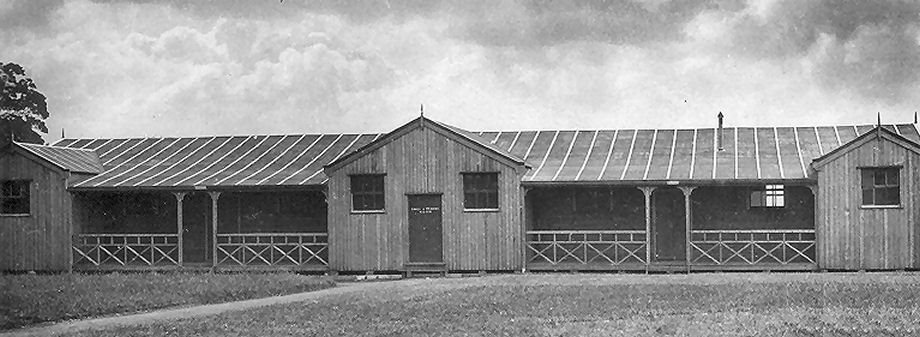
The original constitution of the Institute recorded that…
“The Institute or any part thereof shall be open to each of the inhabitants of Brindle without distinction of sex of the age of fourteen years and upwards, who shall be sober and industrious and of good character“.
and…
“No gambling or playing games for money shall be permitted in the Institute or any part of the premises hereby assured” and that “No intoxicating liquor shall at any time be sold or consumed in the Institute or on any part of the premises hereby assured“.
Today, the current hall has no restriction on the sale of alcohol and a licensed bar is available for all events.
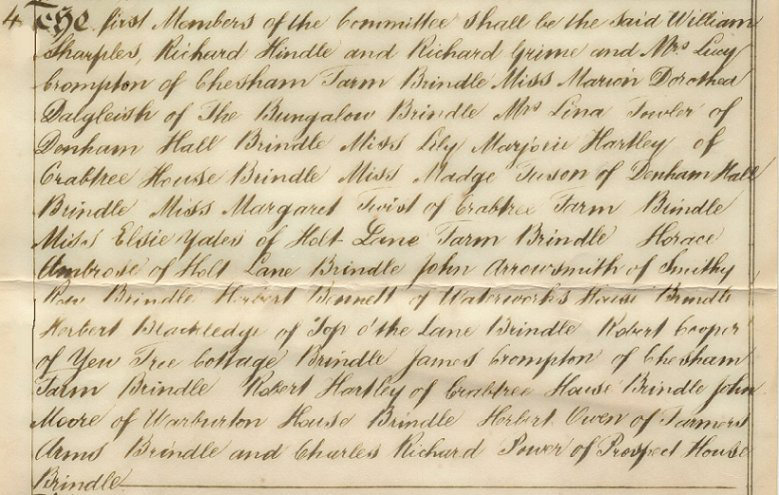
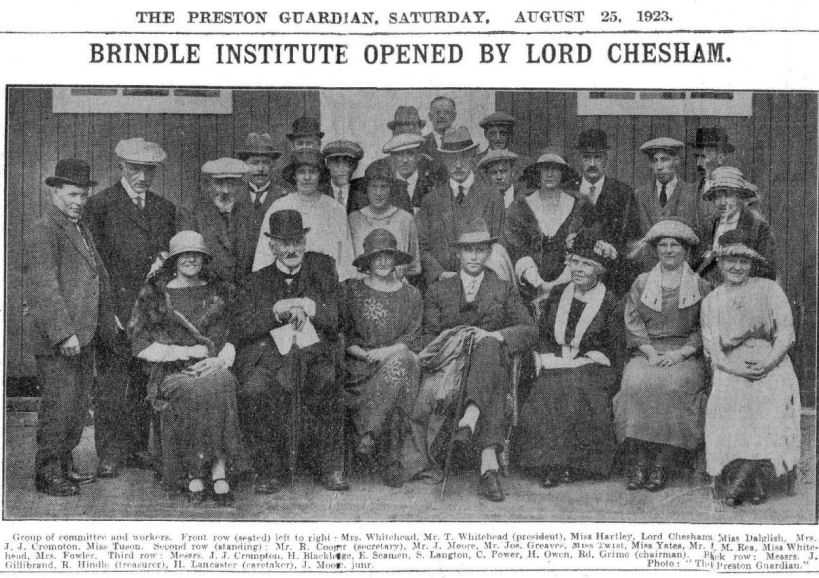
The Institute thrived between the Wars; membership being set at five shillings (25p) per year, and entrance to the weekly Whist Drive and Dance was just a shilling (5p). The facilities were well used, with the hall being open six nights a week (closed on Sundays).
After some hard times during the Second World War, the Institute tried in vain to regain its original popularity and struggled on until its closure in 1958. The original wooden buildings, which had served the village for 35 years, were pulled down and the fixtures and fittings were sold.
A more detailed account of the original Institute and Brindle between the Wars can be found in an excellent book ‘Brindle as I remember it’ by Harold Baxendale.
Despite the field being used occasionally for field days and sports days, the site (like the village) lay dormant for many years until interest was rekindled in the mid-1970s, around the time a new housing development in the centre of the village.

In July 1974 a Public Meeting was held when a resolution was proposed that a working party be set up to investigate the possible development of the Institute. A survey was carried out around the village.
Later in the year, the results of the survey were discussed with 97 replies being received.
At the same meeting, it was considered approaching the Ministry of Defence to ascertain the availability of any surplus Nissan huts to be used as a hall.
At another Public Meeting, held this time in March 1975, just eight members of the public joined five of the Trustees; it was agreed that there was not sufficient enthusiasm for the project to go ahead. Mr. Eddie Ambrose, active in all aspects of village life for many years as Parish Councillor, Churchwarden, and Trustee of the Institute, “expressed his regrets at the lack of enthusiasm shown in view of the wonderful history of the Institute”.
However certain villagers led again by the determined Mr. Ambrose failed to give up on the project. In August 1978, at a Public Meeting attended by 9 Trustees and 72 members of the public support of local residents was canvassed. A motion by Eddie Ambrose “Do we need a new Village Hall” was proposed – being decided by a vote of 45 for and 19 against. The meeting concluded by proceeding with a renewed enthusiasm in investigating the possibility of erecting a new hall.
Debate continued until March 1981 when the Village Hall Study Group reported to another Public Meeting. The discussion involved details of the proposed site, erection, costs; the type of building, the running costs, and anticipated income. The motion proposed by Mr. Harold Ward (a local farmer) “that the buildings be purchased and the work commence.” was carried by a vote of 59 for with 10 members of the public against. At the same meeting, a Village Hall Construction Committee was formed with Messrs. D. Darbyshire, Mr. J.A. Raine, Mr. J.. Charnock, Mrs. M. Charnock, Mr. Gardiner, Mr. J. Cranshaw, Mr. H. Ward, Mrs. Ward, Mr. E. Eccles, Mr. D. Eccles, Miss J. Wilmer and Mr. R. Massey being elected.
Some £11,000 was raised by the local community and went towards the purchase of two wooden huts from Stanley Grange, near Hoghton having seen service since before the War as part of a Lancashire Constabulary training facility.

Work commenced in July 1981 and the building officially opened on 3rd July 1982.
Like the original Parish Institute back in the 1920s, tennis courts were added to the site in 1984 courtesy of Chorley Borough Council.
The Village Hall, as it became known, had its ups and downs reflecting the many social and economic changes over the last twenty years. In 1996 it was agreed to look at replacing the ageing hall and a bid for funding to the National Lottery Charities Board was made in 1999; sadly it was turned down. Whilst efforts continued to place the hall on a sound footing, both financially and structurally, the millennium saw renewed enthusiasm from the Management Committee to replace the building once and for all.
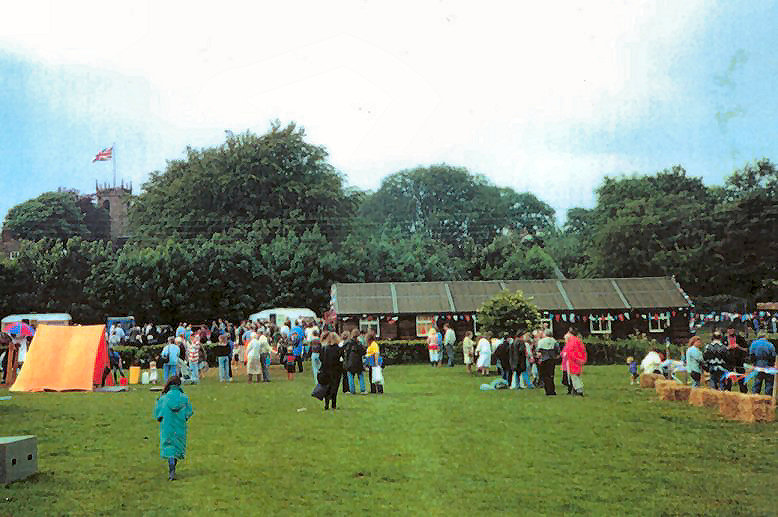
Reflecting its desire to become the focal point of the community once again, the hall was renamed Brindle Community Hall in 2000. Another survey about that time saw increased community involvement and enthusiasm for a new building; this was reflected in greater usage of the hall as new groups began to use the hall on a regular basis, and numbers increased at many of the social events held during the year.
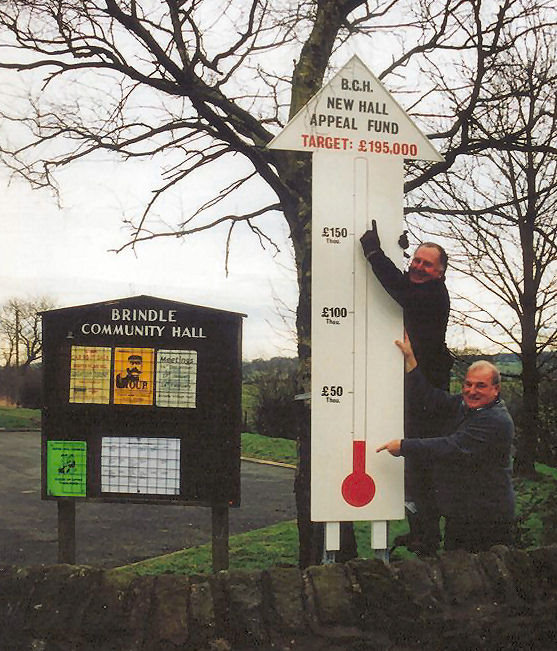
After another approach for Lottery funding in 2002 was declined, the hall Management Committee and many villagers decided to take the matter into their own hands and a campaign to raise the money locally got underway in earnest at the start of 2003.
A figure of £195,000 was quoted to build a new hall fit for the 21st century and in the first month some £3,000 was pledged.
By June 2005 the decision was made to close the 1982 building which had served so well for 23 years. By mid-July, £105,000 had been raised, with a pledge from Biffaward for £50,000 reliant on us finding £23,000 in just 6 weeks! By the end of July, nearly all the money had been raised, including a further £20,000 pledged from another major U.K. charity.
With nearly £200,000 raised, plans were drawn up and contracts were exchanged with local builders, Towers of Blackburn, to build the new hall. Demolition of the old hall took place on the morning of the 26th September 2005.

After planning permission was finally granted a few weeks later, the steel structure for the new building went up on the 20th October and building work started in earnest. Completion came in the Spring of 2006 when, on the 16th March, the new hall was finally handed over by the builders.
The original ethos and aims of the Parish Institute remain the same almost 90 years on. Despite the many changes in our community Brindle Community Hall continues to welcome everyone irrespective of age, race, creed or political persuasion.
We aim for that to continue for the next 90 years.
We would like to acknowledge the assistance of Brindle Historical Society, their Archivists Darren and Katie Cranshaw and local historian Steve Williams in compiling the history of the hall.

Booking Information
How To Find Us
DIRECTIONS: from the B5256 (Blackburn to Leyland road), turn by the Cavendish Arms and St James’ Church into Water Street; the hall is 150 yards on the left, in the centre of the village. If you’re using your Sat Nav to get here, our post code is PR6 8NH.
